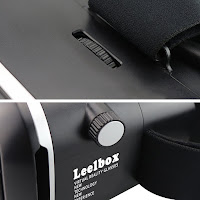The Leelbox Virtual Reality Glasses
This headset includes a few accessories in the box, but none of them are really useful. There’s an instructions manual that covers the details of how to get the headset setup. It also comes with a lens cleaner if the lenses get dirty. There’s also a few adhesive padding pieces, but we haven’t been able to figure out where those go. They’re not mentioned in the instructions and don’t appear to be a replacement for any existing part of the headset. Their absence would likely not be missed anyways.

To use this headset, all you’ll need is a cell phone running iOS or Android. It supports cellphones from 4.7-6”, so just about any newer phone will work. The experience you have will depend largely on what apps you download, and not on the headset itself. When just starting, we recommend the Google Cardboard app, but there’s plenty of others available, and you can even watch 360° YouTube videos by turning your head around.
Setting up the Leelbox Virtual Reality Glasses
Strap Adjustment
The Leelbox headset has a few adjustments to make it more comfortable and easier to use. When adjusting the headset, start with the straps. There are Velcro adjustments on the two side straps. Adjust them to the point where they’ll stretch to the back of your head, but don’t make it too loose. Then adjust the top strap so that the triangle formed by the 3 straps sits in the back of your head. If the strap keeps pulling loose to the top of your head, the top strap is too tight. Keep in mind that the straps are elastic, so they can stretch. It’s better to have them a little too tight than have them loose and let the headset fall to the ground as you’re looking around.Putting in the Phone
The next step is to put the phone in. If you have a thick case on your phone, you’ll need to remove it. Otherwise the magnetic latch for the front plate of the headset will not close. Place the top end of the phone in place first and push up and back until it locks in place. Then, make sure the phone is centered. If there’s any part of the headset that’s weaker than others, it’s probably the phone slider. The plastic that holds the phone in seems flimsy, so be careful when putting the phone in. It’s also at a position that it can accidentally push the side buttons on the phone, such as the lock button or volume controls for iPhone users. Though there are a few problems with this setup, it is still a good solution since it allows many different types of phones to be used.Lens Positioning
 Once the phone is in place, you’ll need to adjust your pupil distance. This adjusts the distance between the lenses, allowing them to accommodate different distances between eyes. To do this, turn the knob on top of the glasses until you can comfortably see the image on the screen. Next, adjust the focus. There’s a knob on the side of the headset that moves the phone forwards and backwards relative to the lenses. This is helpful for people who normally wear glasses, since they won’t fit with the headset on.
Once the phone is in place, you’ll need to adjust your pupil distance. This adjusts the distance between the lenses, allowing them to accommodate different distances between eyes. To do this, turn the knob on top of the glasses until you can comfortably see the image on the screen. Next, adjust the focus. There’s a knob on the side of the headset that moves the phone forwards and backwards relative to the lenses. This is helpful for people who normally wear glasses, since they won’t fit with the headset on. Now you’re ready to experience virtual reality. Put the headset on and look around in your app. The motion of the phone will change the view. Depending on what app you choose, it may be in full 3D.
Review
As far as comfort, this headset is pretty good. The padding is very soft and there’s no feeling of pressure against your face. We did notice on our model that the padding can sometimes pop off it accidentally tugged on, but the plastic piece snaps back into place very easily. The headset is also very light, so it doesn’t pull your head down when you’re wearing it.One thing you may notice when using VR apps on your phone is that it creates a lot of heat. Luckily, the makers of the Leelbox headset came up with a solution. There are holes on either side of the phone compartment that allow air to flow through. Conveniently, they can also be used to keep your headphones plugged in while using the headset. If the phone is still getting too hot, you can remove the front cover. This allows much more air to flow through and should keep the temperature under control.
Limitations
Though the overall build quality of this headset is good and it provides a fantastic VR experience, we recommend limiting your use, or taking short breaks while using the headset. Looking through the lenses for a long time can cause eye strain. Also, depending on the app, there can be a little bit of delay between moving your head and the view changing on the phone. This is enough to cause motion sickness in some people.
Unlike some other headsets, this one does not have a magnetic slider to act as a control while in the app. This isn’t a problem though, since not all phones can even use this. Usually, you can make a selection by looking at a point for long enough.
If you’re looking to get into virtual reality, we highly recommend trying out the Leelbox Virtual Reality Glasses















